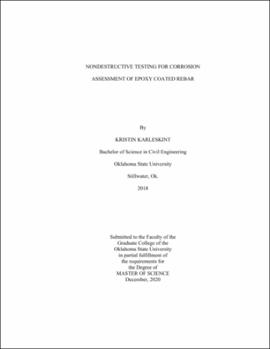| dc.contributor.advisor | Hartell, Julie Ann | |
| dc.contributor.author | Karleskint, Kristin | |
| dc.date.accessioned | 2021-05-25T21:00:30Z | |
| dc.date.available | 2021-05-25T21:00:30Z | |
| dc.date.issued | 2020-12 | |
| dc.identifier.uri | https://hdl.handle.net/11244/330013 | |
| dc.description.abstract | The corrosion of reinforcement is a leading cause of structural deficiency and the reduction of a structure's service life. To enhance structural performance and ensure that each structure meets its intended design life, it is important that corrosion be mitigated and monitored. Epoxy coated rebar (ECR) was first introduced in 1973 and has since been implemented in bridge decks by at least 41 state transportation departments due to the increased usage of deicing salts and the related corrosion problems. It has been observed in some case studies that the inclusion of ECR either increased the risk of corrosion or that it did not improve the corrosion resistance of the bridge deck. Due to an increasing demand for more resilient and sustainable structures, a method to properly test and evaluate the condition of ECR is necessary to determine the service life and to propose an adequate maintenance or rehabilitation program. | |
| dc.description.abstract | The half-cell potential is the most common test for in-situ corrosion assessment, but only provides insight on the probability of corrosion and must be supplemented by other forms of non-destructive testing (NDT). In this study, other NDT methods are used to supplement half-cell potential including: visual assessment, ultrasonic pulse velocity, rebound hammer and pulse echo. High and low corrosion risk areas will be identified in the non-destructive survey and verified with lab testing of cores obtained from these areas. Evaluation of the correlations between the nondestructive survey and mechanical properties of the concrete and reinforcement will determine the efficacy of using this test methodology for corrosion identification in the field. | |
| dc.description.abstract | The proposed methodology will be performed on 9-inch-thick reinforced bridge-deck slabs from I-35 in Oklahoma. The bridge was constructed with both standard and epoxy coated rebar; a corrosion assessment of the standard rebar will be used for comparison and validation of the ECR assessment. The experimental results will reveal the accuracy of the test methodology compared to standard rebar assessment and determine if it is adequate to evaluate the probability of corrosion in bridge decks with ECR. | |
| dc.format | application/pdf | |
| dc.language | en_US | |
| dc.rights | Copyright is held by the author who has granted the Oklahoma State University Library the non-exclusive right to share this material in its institutional repository. Contact Digital Library Services at lib-dls@okstate.edu or 405-744-9161 for the permission policy on the use, reproduction or distribution of this material. | |
| dc.title | Nondestructive testing for corrosion assessment of epoxy coated rebar | |
| dc.contributor.committeeMember | Emerson, Robert | |
| dc.contributor.committeeMember | Shan, Yongwei | |
| osu.filename | Karleskint_okstate_0664M_16904.pdf | |
| osu.accesstype | Open Access | |
| dc.type.genre | Thesis | |
| dc.type.material | Text | |
| dc.subject.keywords | condition assessment | |
| dc.subject.keywords | corrosion | |
| dc.subject.keywords | epoxy coated rebar | |
| dc.subject.keywords | infrastructure | |
| dc.subject.keywords | nondestructive testing | |
| dc.subject.keywords | reinforced concrete | |
| thesis.degree.discipline | Civil Engineering | |
| thesis.degree.grantor | Oklahoma State University | |
